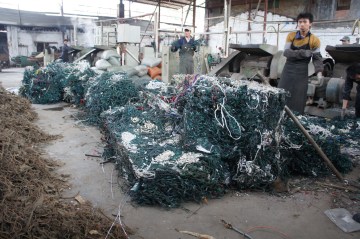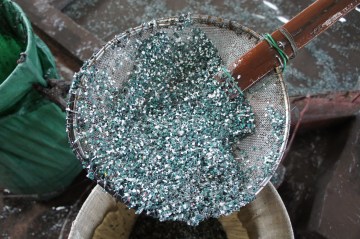A single strand of burnt-out Christmas tree lights weighs almost nothing in your hand. Toss it into a garbage or recycling bin and you won’t have to work any harder to take it to the curb. But what if, just after Christmas, someone were to go door-to-door in your neighborhood and pick-up all of those nearly weightless burnt-out strands of Christmas tree lights. How much would they weigh, then?
That question stopped being theoretical for me in November 2011, when I found myself standing in front of a hay-bale-sized block of burnt out American Christmas tree lights in a warehouse in the southern Chinese town of Shijiao. It weighed, I was told, 2,200 pounds.

Workers stand beside thousands of pounds of imported American Christmas tree lights in Shijiao, China. On average, this factory recycles 2 million pounds of American Christmas tree lights per year.
I wasn’t entirely surprised. For 25 years, Guangdong Province, home to Shijiao, has been one of the world’s most intensive recycling zones, purchasing recyclables from around the planet and transforming them into raw materials to be made into new goods—from iPhones to art books—that are sold around the planet. Indeed recyclables have spent a decade as the top U.S. export, by volume, to China.
(MORE: 7 Things You Don’t Know About the Surprisingly Huge Xmas Tree Business)
That hay-bale-sized block of Christmas tree lights wasn’t the only one in that Shijiao warehouse in November 2011. There were several others—and, were I to come in February or March (high season for recycling old American Christmas tree lights in south China), there would be dozens of others. After all, the warehouse and factory where I was visiting recycles around 2 million pounds of Christmas tree lights every year. Elsewhere in town, I was told, there were 10 others that do similar volumes.
That’s 20 million pounds, easy, weighed out in strands that barely weigh anything. But that’s certainly not the full extent of the waste created by discarded Christmas tree lights every year. After all, not every American bothers to place them into drop-off boxes or the recycling bin, the typical first steps on their journey to a second life in China. Rather, I suspect most Americans—not having a bin marked “Christmas tree lights”—simply toss them into the trash, believing (incorrectly) that they aren’t recyclable in the same way as Evian bottles, craft beer cans, and the other products of American consumption.
But as I learned in Shijiao, they are recyclable. Workers run them through glorified wood chippers and then wash flowing water over the millimeter-sized bits. The heavy copper wire mostly stays in place; the insulation and glass wash away (the process is identical to panning for gold, only in China it’s done mechanically, and on an industrial scale). Once separated, both “streams” are sold to be made into new goods. It’s a clean and sustainable business, insofar as it offers China a less energy-intensive means to get its hands on copper and plastic than mining and drilling.
(WATCH: World’s Largest Christmas Tree)

In China, American Christmas tree lights are reduced to fragments and then separated into copper and plastic using flowing water and the variable weight of the two materials.
And China needs a lot of copper and plastic. As the fabled “workshop to the world,” the place where pretty much everything that anyone could want is made, China is in an endless quest for raw materials. Indeed, it’s the largest consumer of pretty much everything: copper, plastic, paper pulp, aluminum, steel, and anything else that can be made into something new. The list, really, is endless: old American newspapers make new shoeboxes; old car engines make new car engines for Chinese cars; and old Christmas tree lights are used to make everything from brass doorknobs sold at Home Depot to the rubber slipper soles you wear to the beach.
Of course, for many Americans, the words “China” and “recycling,” when combined, don’t conjure up images of safe, green, and sustainable businesses. To be sure, few if any Chinese Christmas tree light recycling factories meet U.S. health and safety standards. But despite the environmental good associated with recycling, it is rarely a black and white matter. Rather, it exists in a gray zone, where one must weigh the costs of extracting copper from insulation against the cost of extracting copper from a mine. That’s a moral calculus as well as an economic one. After all, good intentions don’t turn old beer cans into new ones, and nobody without a profit motive is going to clean up your junk, much less turn it into something new. Put differently, if you and other consumers around the world weren’t consuming so much stuff made in China, there’d be very little need for your Christmas tree lights to go there for recycling.
It’s a point worth thinking about when, in the days after Christmas, Americans load up their recycling bins with packaging, wrapping paper, and old Christmas tree lights, and set them on the curb or in the trash room. Somebody, somewhere, is going to pick up that bin—most likely for free. But they aren’t doing it for the planet, and they aren’t doing it to be green. They’re doing it because, come next year, Americans will want more new Christmas tree lights, and somebody—probably in China—is going to have to make them.
MORE: This Christmas Tree Is Powered by Brussels Sprouts
Adapted from “Junkyard Planet: Travels in the Billion Dollar Trash Trade” (Bloomsbury Press).

